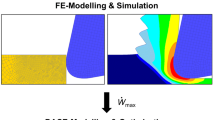Abstract
In cutting processes, the performance and tool life of cutting tools are important evaluation criterions. The cutting edge microgeometry of the tools is in direct contact with the workpiece and thus influences the material flow and the loads on the cutting wedge. Research to date has demonstrated the potential of rounded cutting edges and their improved wear behavior. However, the investigations were always limited to a certain number of materials or processes. For a process-specific design of the cutting edge microgeometry, it must be possible to explicitly describe the material- and process-related contact conditions during machining with rounded cutting edges. Hence, the following article analyzes the chip formation of different cutting edge microgeometries during machining in continuous and interrupted cutting. For this purpose, planing tests on non-ferrous and ferrous materials as well as milling tests on steel alloys with differently rounded cutting tools are carried out and the effects on the chip formation process are analyzed. The results show that the minimum uncut chip thickness hmin correlates linearly to the cutting edge rounding. In addition, the correlation obtained is independent of the cutting process and the workpiece material.









Similar content being viewed by others
References
Denkena, B., & Biermann, D. (2014). Cutting edge geometries. Annals of the CIRP, 93(2), 631–653.
Wyen, C.-F. (2011). Rounded cutting edges and their influence in machining titanium. Ph.D. thesis, ETH Zürich, Düsseldorf.
Bassett, E., Köhler, J., & Denkena, B. (2012). On the honed cutting edge and its side effects during orthogonal turning operations of AISI1045 with coated WC-Co inserts. CIRP Journal of Manufacturing Science and Technology, 5(2), 108–126.
Bouzakis, K.-D., Makrimallakis, S., Katirtzoglou, G., Bouzakis, E., Skordaris, G., Maliaris, G., et al. (2012). Coated tool’ wear description in down and up milling based on the cutting edge entry impact duration. CIRP Manufacturing Technology, 61(1), 115–118.
Wyen, C. F., & Wegener, K. (2010). Influence of cutting edge radius on cutting forces in machining titanium. Annals of the CIRP, 59(1), 93–96.
Denkena, B., Reichstein, M., Brodehl, J., & de Leon Garcia L. (2005). Surface preparation, coating and wear performance of geometrical defined cutting edges. In 8th CIRP international workshop on modeling of machining operations, May 10–11, Chemnitz.
Ulutan, D., Sima, M., & Özel, T. (2011). Prediction of machining induced surface integrity using elastic-viscoplastic simulations and temperature-dependant flow softening material models in titanium and nickel-based alloys. Advanced Materials Research, 223, 475–481.
Waldorf, D. J., DeVor, R. E., & Kapoor, S. G. (1999). An evaluation of ploughing models for orthogonal machining. Journal of Manufacturing Science and Engineering, 121(4), 550–558.
Warnecke, G. (1973). Spanbildung bei metallischen Werkstoffen. Ph.D. thesis, Technical University Hannover, Hannover.
Coelho, R. T., Diniz, A. E., & da Silva, T. M. (2017). An experimental method to determine the minimum uncut chip thickness (hmin) in orthogonal cutting. Procedia Manufacturing, 10, 194–207.
Dib, M. H. M., Duduch, J. G., & Jasinevicius, R. G. (2018). Minimum chip thickness determination by means of cutting force signal in micro endmilling. Precision Engineering, 51, 244–262.
Rehe, M. (2015). Herleitung prozessbezogener Kenngrößen der Schneidkantenverrundung im Fräsprozess. Ph.D. thesis, Leibniz University Hannover, Hannover.
Basuray, P. K., Misra, B. K., & Lal, G. K. (1997). Transition from ploughing to cutting during machining with blunt tools. Wear, 43(3), 341–349.
Bassett, E. (2014) Belastungsspezifische Auslegung und Herstellung von Schneidkanten für Drehwerkzeuge. Ph.D. thesis, Leibniz University Hannover, Hannover.
Bergmann, B. (2017). Grundlagen zur Auslegung von Schneidkantenverrundung. Ph.D. thesis, Leibniz University Hannover, Hannover.
Storch, B., & Zawada-Tomkiewicz, A. (2012). Distribution of unit forces on the tool edge rounding in the case of finishing turning. International Journal of Advanced Manufacturing Technology, 60(5–8), 453–461.
Klocke, F., & König, W. (2008). Fertigungsverfahren 1: Drehen, Fräsen, Bohren (Vol. 8). Berlin: Springer.
Zorev, N. N., Uteschew, M. C., & Senjukow, W. A. (1971). Untersuchung der Kontaktspannungen auf den Arbeitsflächen des Werkzeuges mit einer Schneidenabrundung. Annals of the CIRP, 20(1), 31–32.
Opitz, H., & Gappisch, M. (1964). Die Aufbauschneidenbildung bei der spanabhebenden Bearbeitung. research reports of North-Rhine Westphalia, vol. 1405.
Nasr, M. N. A., Ng, E.-G., & Elbestawi, M. A. (2007). Modelling the effects of tool-edge radius on residual stresses when orthogonal cutting AISI 316L. International Journal of Machine Tools and Manufacture, 47(2), 401–411.
Acknowledgements
The authors would like to thank the research foundation “Verein Deutscher Werkzeugmaschinenfabriken (VDW) for the promotion of the IGF-project 19057N and the German Research Foundation for support the Project DE447/71-2. Furthermore, the authors thank the Walter AG for providing the cutting tools.
Author information
Authors and Affiliations
Corresponding author
Rights and permissions
About this article
Cite this article
Bergmann, B., Denkena, B., Grove, T. et al. Chip Formation of Rounded Cutting Edges. Int. J. Precis. Eng. Manuf. 20, 37–44 (2019). https://doi.org/10.1007/s12541-019-00020-4
Received:
Revised:
Accepted:
Published:
Issue Date:
DOI: https://doi.org/10.1007/s12541-019-00020-4




